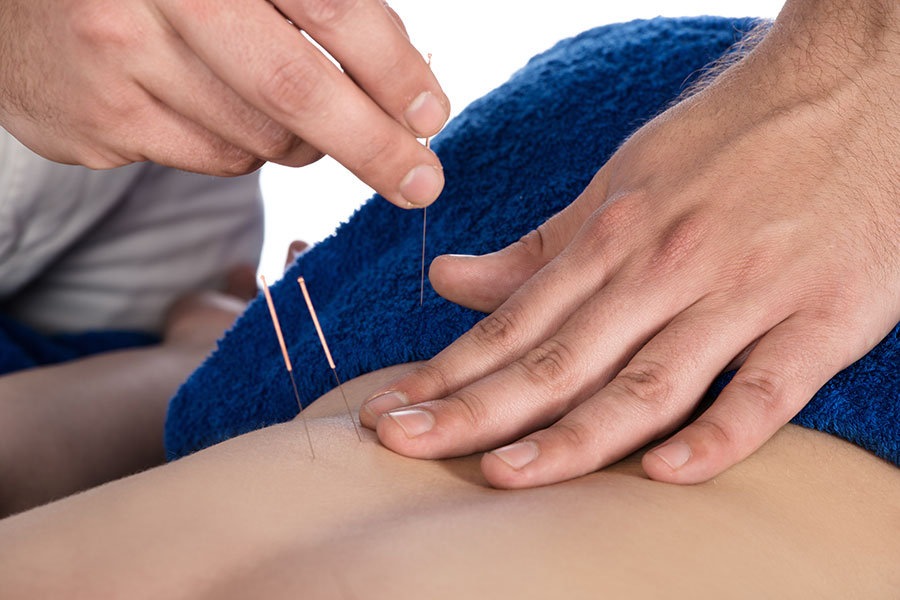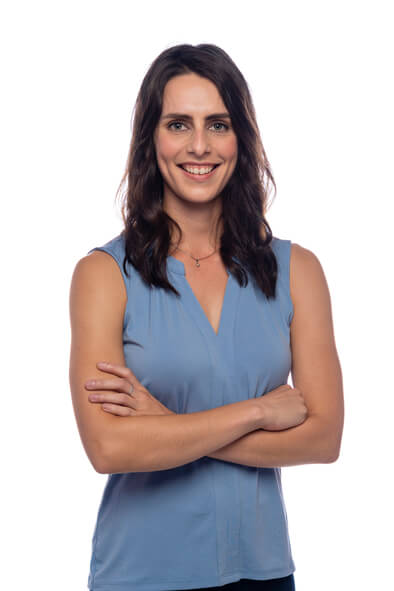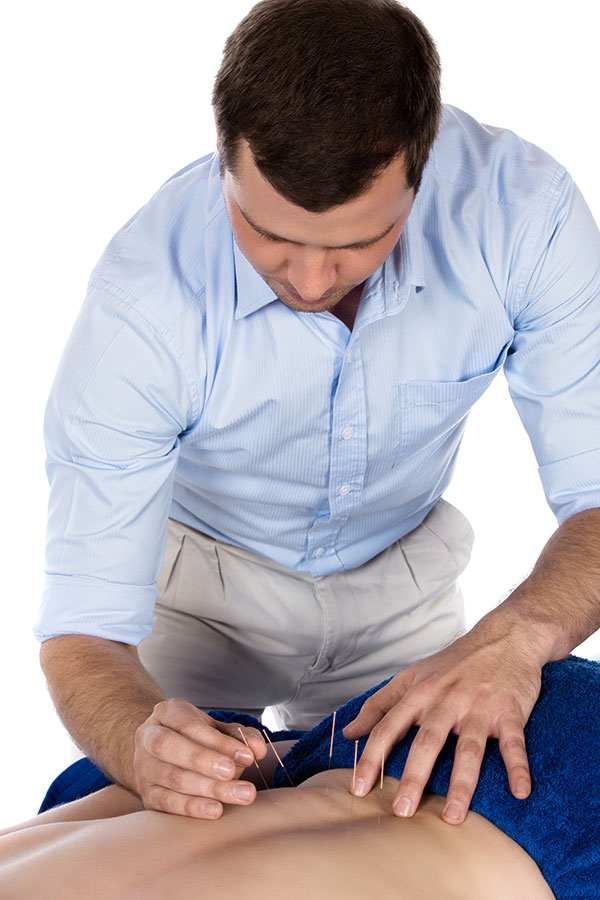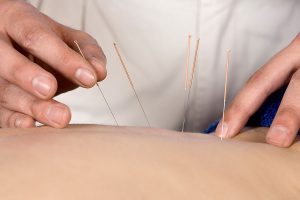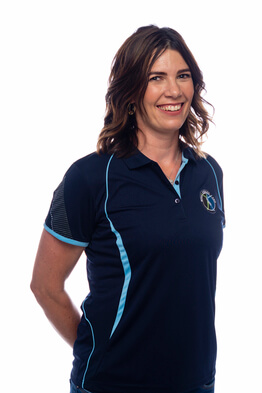Dry needling is Western Medicine’s take on Acupuncture. Just like flour is a versatile ingredient in the kitchen and can be made into sweet or savoury dishes, acupuncture needles can be used for different effects during treatment. We get our needles from the same supplier as a Traditional Chinese Medicine practitioner. It is classified as an acupuncture needle, but we use it for dry needle therapy. Same tool, but completely different technique and application. The clinical reasoning justifies the physiological effects. Many patients assume we do acupuncture, but in fact, medical professionals actually do dry needling treatment.
What exactly is dry needling?
Dry needling physical therapy refers to the needle being free from any medication or substance, it goes into your body “dry”. Techniques are chosen by your physiotherapist to stimulate a local immune response to aid in your recovery so that we get you back to doing what you love in as little time as possible. Dry needle therapy stimulates your body’s own healing response.
Dry needling therapy has been extensively researched by western medicine and scientifically proven in numerous studies. The technique requires the insertion of sterile, stainless steel needles through the skin. The needles we use are solid with a width of only 0,25 or 0,3 mm. An average vaccine syringe is 25 – 38 mm, because it is hollow. Needles used by tattoo artists range from 0,3 – 35 mm. Your muscle bulk and depth of the muscle we target will determine the length of needle we choose. Some calves need only a 30 mm length to get to the problem area, others need a 75 mm needle.
Dry needling therapy is targeted at muscles, but can be used for fascia and ligaments too. Your physiotherapist determines what tissue needs treatment after a thorough assessment. Dry needling is very effective in stimulating the body to heal itself and relieve acute or chronic pain.
Why we use physiotherapy dry needling
Dry needling therapy activates a localized immune response by increasing circulation to the area. This initiates and accelerates the healing of the tissue at the site of the injury. Active trigger points form as the body’s response to injury in an attempt to protect the injured tissue from further damage. These trigger points can by painful and restrict movement, decreasing muscle length. Dry needling therapy increases muscle length and gets rid of the trigger points. Once muscle length is restored the tension on the tendon, where muscles attach to bone, is decreased which also lessens pain intensity. Once the range of motion is restored we can initiate rehabilitation exercises so that you can get back to participation in sports or training activities.
Healing Effects of dry needling physical therapy
- Decrease pain
- Increase circulation
- Accelerate tissue healing
- Decreased recovery time
- Break down scar tissue and adhesions
- Improve muscle flexibility
- Decrease muscle spasm
- Improve joint range of motion
“Dry needling physical therapy is one of the quickest ways to improve range of motion”
What can I expect with needling treatment?
Physiotherapy dry needling is part of the treatment, in conjunction with other techniques. Dry needling treatment takes 2 and 10 minutes, depending on structure being treated. Physiotherapists are qualified to determine if dry needling will benefit you.
First, your physiotherapist will explain why dry needling will benefit your specific situation and get your permission to use needles. The area is exposed and cleaned with an alcohol solution. Your physiotherapist determines the length and amount of needles that’s necessary. Larger areas may require more, and deeper structures needs longer needles to reach. Expect to feel a pin prick when the needle enters your skin, followed by a small, involuntary muscle contraction or twitch response. Although this feels strange, it is exactly what we are after. A local twitch response stimulates the action potensial of the muscle cell. Action potensials are how our nerves instruct our muscles to move. During this twitch or action potensial the permeability over the cell walls change, normalising the ion balance outside and inside of the cells.
The needles are removed when the twitch response stops. Your muscles will feel tender for the rest of the day, like you did an entire workout of only those muscles. Tenderness, bruising and swelling are normal side-effect of dry needling treatment.
Your physiotherapist will guide you through the right aftercare that you can do at home to improve the effects.
Physiotherapy dry needling is part of the treatment, in conjunction with other techniques. Dry needling treatment takes 2 and 10 minutes, depending on structure being treated. Physiotherapists are qualified to determine if dry needling will benefit you.
First, your physiotherapist will explain why dry needling will benefit your specific situation and get your permission to use needles. The area is exposed and cleaned with an alcohol solution. Your physiotherapist determines the length and amount of needles that’s necessary. Larger areas may require more, and deeper structures needs longer needles to reach. Expect to feel a pin prick when the needle enters your skin, followed by a small, involuntary muscle contraction or twitch response. Although this feels strange, it is exactly what we are after. A local twitch response stimulates the action potensial of the muscle cell. Action potensials are how our nerves instruct our muscles to move. During this twitch or action potensial the permeability over the cell walls change, normalising the ion balance outside and inside of the cells.
The needles are removed when the twitch response stops. Your muscles will feel tender for the rest of the day, like you did an entire workout of only those muscles. Tenderness, bruising and swelling are normal side-effect of dry needling treatment.
Your physiotherapist will guide you through the right aftercare that you can do at home to improve the effects.
Are there different types of physiotherapy dry needling?
Different facilities offer dry needle therapy post graduate training. Some schools teach a passive approach, where the needles are inserted and left in for a certain duration. Some schools teach an active approach where the needles are inserted and taken out when no more twitches are observed. Both are equally effective.
Dry needle therapy treats muscle injuries. Tendons, ligaments, or scar tissue can also be treated. This is usually a technique of shorter duration, with smaller needles, and is a little more painful. At least it is over quick.
Dry needling also treat sinusitis or allergic rhinitis to relieve pain and improve airflow. Small needles are inserted across the face for approximately 5 minutes.
We never use electrical stimulation with dry needle therapy at our practice. With this technique, electrodes are attached to the needles and a current is sent through the needle into your body. We discourage this technique as it causes more harm than good.
The amount of needles used during your treatment will be specific to your unique condition, fearfulness and therapist. For someone who tolerates dry needling well and isn’t scared up to 20 needles or more can be used in a single session. For the first treatment of someone who feels frightened we will negotiate. Let’s try one or two and see how you feel. Mostly patients are surprised at how different it feels from what they expected. It is not an injection, it is over quick and very effective.
Big anatomical changes you’ll notice after physiotherapy dry needling
The effects of dry needling on the cell are microscopic, but when all the cells react in this way the change is big. You can experience the muscle feeling warm because the circulation is improved. Bruises are not intended but may happen with treatment. A dull, deep ache for the rest of the day is due to the inflammatory cells present in the area, which we want there and invited there to initiate healing. You will immediately feel a difference in range of motion and flexibility because of the twitch response elicited by the needles. Now that we have created this atmosphere inside of you we can use the freedom of movement to initiate rehabilitation exercises through your new range, and add control, balance, and proprioception to the injured area.
Pain is improved because of the release of endogenous opioids (made within your own body), bradykinin and substance P. These neurotransmitters block the nociception messages and you feel less pain.
Small changes on a cellular level with dry needling physical therapy
Dry needle therapy stimulates a local immune response. Our immune systems don’t only fight infection, they detect, sound the alarm and rush all the cells necessary for healing to the area. Once the needle is inserted blood flow is increased to the specific area. The immune reaction is driven and sustained by the release of cytokines. Cytokines are a group of cells, proteins, peptides or glycoproteins, that regulate the immune response by means of inflammation. It is like getting all the emergency care workers to the site of the accident.
Different cytokines and their effects:
- Granulocytes are white blood cells responsible for helping the immune system fight infection, like viruses or bacteria. Neutrophils, eosinophils, and basophils are three types of granulocytes. They go around your body like little pack man and devoure all the invaders.
- Neutrophils are white blood cells that initiate an immune response. They circulate within your bloodstream and respond to the first signs of infection. They set off the alarm to call the other cells for help.
- Basophils contain anticoagulants, which prevent blood from clotting too quickly. They also contain the vasodilator histamine, which promotes blood flow to tissues by changing the permeability of the cell walls.
- Macrophages are like scavengers that rid the body of worn-out cells. They are vital to the regulation of immune responses and the development of inflammation; they produce a wide array of powerful chemical substances (monokines) including enzymes, complement proteins, and regulatory factors such as interleukin-1.
- Lymphocyte T and B cells are the major cellular components of the adaptive immune response. T cells are involved in cell-mediated immunity, and B cells are responsible for acquired immunity.
Dry needling initiates this cascade of cytokines released to the area and kick starts healing when all the different cells do their jobs.
What are trigger points?
Trigger points are palpable bands within a muscle belly, they can feel like a thickening of fibers or a knot. Myofascial trigger points form because of the excessive release of the neurotransmitter acetylcholine. This in turn causes the release of potassium ions, histamine, serotonin and bradykinin which stimulate nociceptors. Nociceptors are the nerves that relay actual or potential tissue damage from the body to the brain. Trigger points can cause local or referred pain, muscle weakness, and limited range of motion.
These knots are formed as a protective strategy by the muscles to prevent or limit tissue damage. They can form because of injury, change of loading with exercise of new activities, and prolonged positions. Trigger points cause pain due to decreased blood flow. This changes the pH within the muscle and triggers the release of prostaglandins, which decreases the pain threshold and ultimately causes an increase in pain.
Dry needling therapy aims to reverse this chain of events by improving circulation to the area.
Dry needling physical therapy feels like:
Your physiotherapist will first explain the goal and benefits of dry needling treatment to you. We will ask for consent to use dry needling. Now we expose and clean the area and position you so that there is no strain in the tissue. No anesthesia is used with dry needling. You can expect to feel a pin prick when the needle enters. The actual inserting of the needle does not hurt—these needles are very thin. Sometimes the muscle will twitch when the needle is inserted, and it can feel sore if that happens. This small, involuntary muscle contraction or twitch response is a good sign.
Needles are invasive, it is something from outside entering the body. The body views this as a threat initially. Just like a mosquito bite itches initially and then the sensation fades, when the needles aren’t considered a threat to your body anymore, you won’t be able to feel them at all.
Your physiotherapist might do needles to one muscle only, or a few different muscles in one session. It depends on your specific condition. A therapist is guided by your muscle’s response and at any point, you’re allowed to tap-out. There’s no need to push through the pain. Some patients report feeling like “that’s the center of my pain” followed by immediate relief.
Please remember we won’t do anything that you do not feel comfortable with.
How long does dry needling treatment take?
Treatment times vary per condition. It can be as little as 20 seconds in one muscle or up to 5 minutes, depending on the depth and size of the muscle.
However, dry needle therapy will only be a part of your treatment session. Our physiotherapists always combines it with soft tissue techniques, massage, joint mobilisations or stretching to amplify its effect and last longer.
How many times should I get dry needle therapy?
You feel the effects of dry needling after your first session. It is used repeatedly for a few weeks and done in each treatment session, guided by the goal we want to achieve.
Your physiotherapist will discuss a treatment plan with you. We’ll give you an idea of how long it takes for your condition to improve and how often treatment is needed. In some cases we’ll need 6-8 sessions. Mostly we see you twice during your first week, and once a week for the next two weeks and then once every second week in the next month.
If you are immune-suppressed due to other medical treatment, we will need more regular sessions to achieve the same results. People suffering from auto immune disease may experience more side effects after treatment, because of heightened immune response. Care will be taken when determining dosage of your physiotherapy treatment.
What can I do at home to ensure dry needling is effective?
The effects of dry needling are temporary if the root cause of your problem isn’t addressed. Our physiotherapists look at the bigger picture and discuss the causes and contributing factors of your pain. With physiotherapy treatment, it is important to comply to the whole treatment plan, including rehabilitation and conditioning. This is the best way to get long-lasting pain relief.
There are a few things you can do at home:
- Stretch
- Apply heat to the treated area
- Do your prescribed home exercises
Cost of dry needle therapy
There are certain medical aid rates for dry needling. It forms part of a complete treatment consultation. So, you will never be paying for only dry needling therapy.
This treatment in isolation will not fix your problem. It’s the complete treatment package that shows the real improvement. We use it with other treatment techniques to amplify a physiological healing effect.
Medical Aid Code – 328
The treatment code for dry needle physiotherapy is 328. Most good medical aids offer re-imbursement for dry needling. This code is charged irrespective of how many, or how long the needling therapy takes.
Does it make a difference to have an experienced physiotherapist do dry needling?
Absolutely! The experience and skill of your physio makes all the difference to identify and apply the technique safely and accurately. This is not something you can do or copy form YouTube. Unsterile and unsafe practice can cause big problems.
Our physiotherapists have years of clinical experience and in depth knowledge of your body’s anatomy. They understand different painful conditions and injuries and will know exactly what dry needling therapy techniques are suitable to help you heal quicker.
Answers to other physiotherapy dry needling treatment questions:
